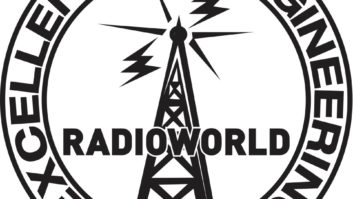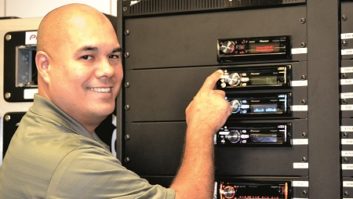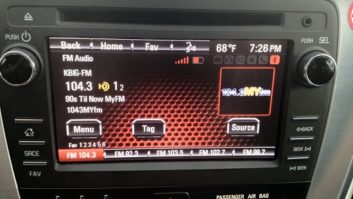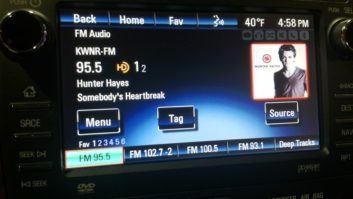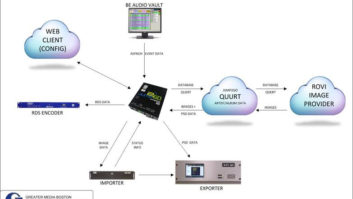IBiquity Digital President/CEO Bob Struble has always been upbeat about the outlook for HD Radio; but these days he’s expressing a refreshed sense of optimism. He believes more stations will convert to digital and that others will upgrade digital power to allow the transmission of more data services.
“The industry hasn’t spent money for a few years. There’s basic maintenance, upgrades, etc. [that need to be done], and I think we’ll benefit from that.”
He senses that many broadcasters who are planning to upgrade plants, even in small markets, will convert to digital at the same time.

This VW HD Radio displays an image of Randy Travis while one of his songs airs on the HD2 channel of KWNR(FM), Las Vegas. Photo by Leslie Stimson
Vendors at the recent NAB Show seem to share his optimism. They told Radio World that stations plan to spend more on upgrades this year and some are expressing interest in converting to digital or upgrading HD Radio power.
Here’s more on HD Radio news from the show.
Development Work Aims at Radio in Cellphones
NAB’s program called FASTROAD — “Flexible Advanced Services for Television & Radio on All Devices” — is supporting efforts to encourage the integration of HD Radio into cellphones and other portable devices.
The return path provided from a phone or other device back to the station has the potential to elevate radio’s ROI from HD Radio, according to proponents.
“We think the return path has business potential” for both stations and advertisers, said Emmis Communications President/CEO Jeff Smulyan. “We think we can provide couponing from a phone. Near a point-of-purchase we can provide a call to action. We think it’s a game-changer for us and benefits the wireless services.”
For years proponents have hoped to see HD Radio used in cellphones, most likely after analog FM penetrated such products. Current development work is aimed at supporting both.
NAB says new chip designs allow the use of an integrated antenna rather than one built into the headphone cord. NAB also has signed a contract with Silicon Valley company SiPort to develop an HD Radio application for iPhone and Android that works with an FM HD Radio chip in mobile devices. SiPort specializes in chips that consume less power and occupy less space, as required by portables. Its chip is used in the Insignia HD, for example.
BIA is the project manager, and iBiquity and the Broadcast Traffic Consortium are involved.
Their view is that a cellphone with HD Radio reception and associated app becomes an “end-to-end” system, providing not only a broadcast path from station to listener but also a return path to the broadcaster and an additional back channel to the user. This allows more interactivity between the digital broadcaster and the consumer.
BTC is driving the broadcast side while iBiquity and SiPort are working on app development.

In two vehicles, iBiquity demoed HD Radios with the Artist Experience feature. It also ran a contest linked to live images displayed by KWNR(FM) HD2 at certain times. Booth visitors received a card with a description of a vehicle equipped with HD Radio technology. Attendees whose cards matched the images displayed in the booth won portable Insignia HD Radios. © NAB
“In our minds, cellphones would have the receiver in them and you’d use the app to get [the interactive aspects of] HD Radio,” said Lane Bruns, iBiquity vice president of portable products. Wireless companies would spend less than $4 to add an HD chip to a handset, he said.
Talks are underway to involve other chipmakers in the development. IBiquity President/CEO Bob Struble believes the HD app will be ready this year.
Struble: Stations Should Roll Out AE Soon
Development work is underway at various radio groups to implement Artist Experience, the HD Radio feature that enables images to be synched with audio, Bob Struble said.
That effort will proceed, he continued, regardless of whether the government mandates FM chips in devices.
Clear Channel is beta testing the AE feature in 18 markets. Supplier Jump2Go offers a solution, as does Broadcast Electronics, while the Broadcast Traffic Consortium of station owners is working on one.
Struble says that for AE to work, the station’s automation system must recognize the content ahead of scheduled air time and look up the associated images. That data is transmitted along with the HD Radio signal and stored in the receiver. When the song or other content plays, the associated image displays.
Although manufacturers and developers are finding ways to make this work, Struble said he worries the process isn’t happening fast enough. Some radios on the market have the capability to display Artist Experience now, and more will come this summer as automakers will roll out new models.
A Call for a New Car Strategy
Broadcast Traffic Consortium leader Paul Brenner echoed Struble by saying radio needs to go digital and offer advanced data services to compete with other media, especially in the dash.
“In this digital space, where you’re competing to be prominent or dominant against the other digital mediums, you have to be able to deliver this kind of technology.”
He described sitting with iBiquity Digital in meetings across the table from automakers, trying to persuade them that terrestrial radio can deliver traffic data with lower operating costs and more efficiently than satellite and mobile broadband can.
At least half of all new cars out in 2012 will have digital dashboards. Internet radio for the car has been in production for years but terrestrial radio is “kind of late” to the party, he said. “Digital radio is not optional. We need to show [automakers] the analog radio industry has a plan.”

The newest HD Radio portable that displays images synched to audio is the Cydle P29H. The unit has a 2.9 inch screen, MP3 player and rechargeable battery. Photo by Leslie Stimson
Struble went further, saying that more HD Radio receivers are coming for cars, homes, and soon, broad-based mobile devices. “Those radios display very compelling digital capabilities. If your station is not showing these, it’s going to be left behind, and the consumer’s going to have a bad experience.”
Shortly after the show, Jacobs Media President Fred Jacobs called for the formation of a task force to address the issue of radio’s position in the dash.
Doyle Concerned About Adoption
FCC Audio Division Chief Peter Doyle said he’s concerned about the slowdown in HD Radio conversions and the relatively low number of stations that have raised FM digital power levels.
In an interview with Radio World, Doyle said 1,627 stations had converted to digital by early April, or about 16 percent of total stations. The conversion rate has slowed to “maybe a handful” each month, he said, attributing much of that to the poor economy.
Station engineers have told Radio World that cuts in capital expenditures have affected the pace of digital conversions and power increases. Critics say stations that intended to adopt the technology have largely done so and that conversions have peaked.
Struble told Radio World the poor economy accounts for the slowed numbers. “It’s dollars, pure and simple. There’s not a lot of dollars sloshing around for capital expenditures, although that is improving; in that sort of environment I think you’ll see a gradual upgrade.”
We’ve previously reported that as of early March, 225 FMs had increased digital power. The pace concerns the Audio Division chief.
“Replicating analog coverage is such an important part of this I would hope for greater broadcaster action to take advantage” of the power increase, which the agency approved last year, Doyle said.
HD proponents believe many more facilities would qualify if the agency were to allow stations to raise digital sidebands unequally, or “asymmetrically,” in order to protect neighbor stations from potential interference.
Asymmetrical Sideband Drive Test Results Are In
IBiquity, NPR Labs, Nautel and WAMU(FM) in Washington detailed their latest test results comparing symmetrical to asymmetrical HD sideband transmission and reception. They said the field data essentially confirm lab results presented at the fall Radio Show.
“We think the ability to apply asymmetric power is very useful,” said Russ Mundschenk, field test and implementation manager for iBiquity Digital. He presented results based on tests that used the digital signal of Greater Media’s WKLB(FM), Boston.

IBiquity Digital Manager of Broadcast Marketing Roy Sampson demos the VW HD Radio featuring Artist Experience. © NAB
The station and iBiquity conducted tests south to Warwick, R.I. and north to Manchester, N.H., comparing digital symmetrical vs. asymmetrical sideband transmission at –14 dBc, –10 dBc and –17 dBc.
WAMU, like WKLB, has experimental authority from the FCC to operate at digital power levels above –14 dBc and with asymmetrical sidebands. WAMU is using Nautel’s PowerBoost technology.
In drive tests in rural Virginia, the team tested reception using symmetrical vs. asymmetrical digital sideband transmission. The asymmetrical sideband power was –13 dBc on the low side and –17 dBc on the high side (the symmetrical equivalent levels of –10 dBc, –14 dBc).The asymmetrical sideband operation with –13/–17 dBc increased the total digital power close to the theoretical 493 Watts, compared to –14 dBc symmetrical operation. Station personnel noticed that the HD Radio signal extended several miles farther than it had before, and there were some spots where dropouts were filled in.
Nautel’s Hal Kneller said WAMU did not notice deleterious effects to its analog signal with the HD PowerBoost operation at any of the sideband levels tested with asymmetrical operation, nor was there any apparent affect at –14 dBc with HD PowerBoost on or off.
Parties involved with both tests told Radio World they intend to meet with the FCC about the results.
CAP EAS Alerts Transmitted Using HD Radio
Global Security Systems, Sage Alerting Systems and iBiquity say HD Radio broadcasts can transmit next-gen EAS audio and text messages using the Common Alerting Protocol.
On April 6, WTGE(FM), Baton Rouge, La., became the first HD FM station to broadcast CAP-EAS messages over HD Radio, according to participants. The Guaranty Broadcasting station used a Sage Digital Endec.
CAP-EAS messages are received on the Endec via GSSNet, a satellite data delivery system, or the Internet. The messages are processed, converted and transmitted using an HD signal, where the alerts are heard on enabled HD Radio receivers. Arthur “Bo” Hoover, veteran broadcast engineer and Technical Service Group president, facilitated the installation at the station along with Sage and GSS.
Test CAP EAS messages with text were sent across an HD Radio broadcast channel successfully, according to Sage, iBiquity and GSS; they said this verifies that HD Radio is compatible with the Integrated Public Alert and Warning System and other emergency notification systems, including Alert FM. The tests also show CAP EAS is compatible with AM transmission, according to Sage, iBiquity and GSS.
Sage, iBiquity and GSS said EAS messages now can be broadcast audibly through analog FM and with audio and text over HD Radio via the Sage Endec, as well as textually through Alert FM’s use of RDS.
